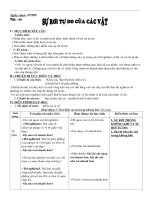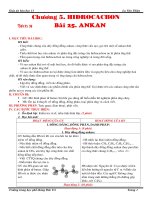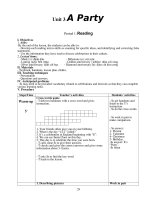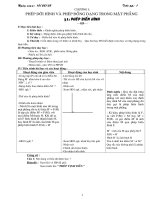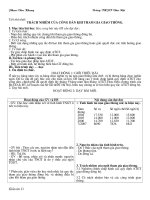GA 11. U3+U4 CB
Bạn đang xem bản rút gọn của tài liệu. Xem và tải ngay bản đầy đủ của tài liệu tại đây (221.76 KB, 24 trang )
Unit 3: A Party
Period 1: Reading
I. Objectives
1. Aims:
By the end of the lesson, the students can be able to:
- Develop such reading micro-skills as scanning for specific ideas, and identifying and correcting false
statements.
- Use the information they have read to discuss celebrations in their culture.
2. Lexical items:
- Mark (v): ®¸nh dÊu - Milestone (n): cét mèc
- Lasting (adj): bÒn v÷ng - Golden anniversary / jubilee: ®¸m cíi vµng
- Silver anniversary: ®¸m cíi b¹c - Diamond anniversary (n): ®¸m cíi kim c¬ng
II. Materials
- Textbook, handouts, lesson plan, chalks.
III. Teaching techniques
- Presentation
- Questions and answers.
IV. Anticipated problems
Ss may need to be provided vocabulary related to celebrations and festivals so that they can complete
various learning tasks.
V. Procedure
Steps/Time Teacher s activities’ Students activities’
29
Warm-up
5’
Cross words game
- T delivers handouts with a cross word and gives
instruction.
1. Your friends often give you on your birthday.
2. What is the day “14-2” called?
3. It’s a celebration in England beginning with “E”.
4. We can see Santa Claus on this day.
5. This day is to celebrate the time you were born.
- T calls some Ss to give their answers.
- T checks and gives the correct answers and gives some
information about 3- Easter.
- T asks Ss to find the key word.
- T leads in the lesson.
- Ss get handouts and
listen to the T’s
instruction.
- Ss do the cross words.
- Ss work in pair to
make comparison.
- Ss answer:
1- Present
2- Valentine
4- Christmas
5- Birthday.
-Ss answer: It’s
“Party”.
-Ss listen
Pre-
Reading
10’
1. Describing pictures
- T asks Ss to look at the pictures, work in pair to answer
the questions.
1. What is the relation between the people in the pictures?
2. What are they celebrating?
- T calls some Ss to give their answers.
- T gives comments and suggested answers:
Picture 1: they belong to a family. They are celebrating a
birthday.
Picture 2: they might belong to a family. They are
celebrating a wedding anniversary.
2. Pre-teaching vocabulary:
Mark(v): ®¸nh dÊu
Milestone(n): cét mèc
Golden(a): b»ng vµng
Golden anniversary/jubilee: ®¸m cíi vµng
Silver anniversary/jubilee: ®¸m cíi b¹c
Diamond anniversary/jubilee: ®¸m cíi kim c¬ng
- Before teaching these words, T helps Ss to pronounce
them correctly.
- T presents or elicits the meanings of these words from the
class.
- T gets Ss make sentences with these words.
- T gives corrective feedback.
Work in pair
- Ss work in pair and
answer the questions.
- Ss give their answers.
- Ss listen.
- Ss write new words in
their notebooks.
- Ss practice
pronouncing these
words.
- Ss make sentences.
- Ss listen.
- T sets the scene: You are going to read about how
- Ss listen.
30
7’
While you
read
10’
American people celebrate birthdays and wedding
anniversaries. Then you do the tasks that follow.
1. Task 1
- T gets Ss to read the passage silently and then do Task 1.
T may want to give them some tips to do the task.
+ First, Ss should skim the seven statements to understand
them. As Ss do this they underline the key words to decide
what information they need to find in the Text.
+ Then they should go back to the passage and locate the
key words in the passage.
+ Then they should read the key words carefully to find the
answer.
- T gets Ss to check their answers with a peer.
- T calls on some Ss to give their answers and asks them to
explain their choices.
- T checks the answers with the whole class.
Answers:
birthday wedding
1. People sing a song
2. People eat cakes.
3. People receive cards and
gifts from friends and relatives.
4. People joke about their ages.
5.People remember their wedding
days.
6. People go out to dinner.
7. People blow out candles, one for
each year.
2. Task 2
- T checks if Ss can identify and correct the wrong
information in Task 2 after their first reading the passage. If
they cannot, T gets Ss to read through all the 7 questions in
Task 2 and identify the key words in each question. For
example, in question 1, these might be “Lisa s family and ’
friends ” and eighth birthday .“ ”
- Now T instructs Ss to go back to the passage and locate
these words. Ss should read around these words carefully to
find the answers.
- Then T gets Ss to check their answers with their friend.
- T calls on some Ss to give answers and explain their
answers.
- T gives feedback and correct answers.
Answers:
1. eight seven
2. makes eats
3. food presents
4. anniversaries ages
5. months years
6. 5
th
50
th
- Ss listen to the
teacher and take note
some tips to do this
task.
- Ss may ask the
teacher to give some
examples.
- Ss check their
answers.
- Ss answer and
explain.
- Ss listen and check.
- Ss listen to the T’s
instruction.
- Ss do as conducted.
- Ss check their
answers.
- Ss listen and check.
31
7. silver golden.
Post-
reading
10’
- T introduces the task: Ss work in small group of 3 or 4 and
discuss questions.
- T teaches structures that can be used for giving
comparison and contrast. E.g. “In the US, people but in …
Vietnam, people , Americans while Vietnamese , …” “ … …”
Americans In contrast, Vietnamese , “ … …” etc.
- T goes around checking and offering help.
- T calls on some groups to tell and explain their choices.
- T gives corrective feedback.
- Ss listen.
- Ss listen and take
note.
- Ss work in group.
- Some groups give
their answers.
- Ss listen and check.
Wrapping
up
3’
- T summarizes the main points of the lesson.
- For homework, T asks Ss to write a paragraph about how
Vietnamese people celebrate their birthdays or wedding
anniversaries, based on the text they read in class.
- Ss listen and write
down homework.
Period 2: Speaking
I. Objectives
By the end of the lesson, Ss will be able to:
- Use appropriate language to talk about parties and negotiate how to plan them.
- Use appropriate language to invite people to come to the parties.
II. Materials
- Textbook, lesson plan, chalks.
III. Teaching techniques
- Presentation
- Questions and answers.
IV. Anticipated problems
Ss may have little experience negotiating in English, so T should be ready to provide them with
appropriate language to do so.
V. Procedure
Steps/Time Teacher s activities’ Students activities’
Warm-up
7’
Talking about the parties.
- T raises some questions and asks Ss to work in pair to
discuss them.
1. Do you like parties?
2. Have you joined a party?
3. Whose party was it?
4. On what occasion?
5. Where was it?
6. Was it fun?
- T sets the scene: “Supposed you have been to a party and
now you want to tell your friends about it. What do you
want to tell?”
- T calls on some Ss to make conversations using the
questions above.
- Ss work in pair to
discuss these questions.
- Ss listen.
- Ss make
conversations.
- Ss listen.
32
- T gives comments.
Pre-teaching necessary language.
A birthday/ housewarming party.
A family/ social gathering
To give a party
To enjoy oneself
To have fun.
Soft drink
Snack
- T gives examples when presenting these words.
- T introduces the topic: Talking about the parties.
-Ss listen and take note
some new words.
- Ss listen.
Task 1
7’
Task 2
7’
- T introduces the task and goes over the questions with the
class. T explains new words if necessary.
- T gets Ss to do the task individually. Ss need to choose the
details they want to talk about and plan their stories. T
encourages Ss to take note while doing so.
- T goes around the class to check and often help.
- T calls on some Ss to deliver their talks.
- T gives comments.
- T puts Ss work in pairs and gets them to tell each other
about the parties they have been to based on the outlines
they have made for Task 1
- In the meantime, T goes around checking and offering
help.
- T calls on some pairs to perform their conversations in
front of the class.
- T elicits feedback from the class and gives final
comments.
- Ss listen and take not
some new words if
necessary.
- Ss work individually
and do as instructed.
- Ss work.
- Some Ss deliver their
talks.
- Ss listen.
- Ss listen and work in
pairs –
- Ss make
conversations.
-Some Ss perform their
conversations.
- Ss listen.
Task 3
12’
- T introduces the task and asks if Ss have ever planned a
party with someone else. T elicits things they consider
when planning a party. T may want to ask Ss to look at
Task 3 for the answers and while pooling their ideas, T
writes them on the board.
- Ss listen, look at the
task 3 and give their
ideas.
33
When?
(date&time)
Where?
(home/
restaurant)
Entertainment?
(dance/music/
games)
Dressing
codes
(formal/
informal)
Planning a
party
Budget?
spend/
contribute)
- T teaches some useful expressions for negotiating, i.e.
asking for and giving opinions, expressing agreements and
disagreements, suggesting and stating preferences.
- T gives examples and gets Ss to do some practice.
- T asks Ss to work in group of 3 or 4 to negotiate so as to
come up with a plan for their parties.
- T goes around to check and help.
- T calls on some Ss to give their talks.
- T gives comments.
- Ss listen and take not
some useful
expressions.
- Ss do some practice.
- Ss work in group.
- Ss give their talks.
- Ss listen.
Task 4
10’
- T introduces Task 4: Ss informing of their coming parties
and inviting people to come.
- T elicits the verb tenses and structures Ss might use.
- T teaches some expressions for inviting and persuading.
E.g.
Would you like ?…
We would love to have you .…
We welcome your presence…
It s our pleasure to invite you’ …
- T gets Ss to do some practice with these structures.
- T asks Ss to work in group.
- T calls on the representative of each group to report about
the parties that they have planned. T gets other groups to
take notes while listening to their peers.
- T gives comments.
- Ss listen.
- Ss listen and take
note.
- Ss do some practice.
- Ss work in group.
- Ss deliver their
reports.
- Ss listen.
Wrapping
up
2’
- T summarizes the main points of the lesson.
- For homework, T asks Ss to write a paragraph about a
party they have been to.
- Ss listen and write
down homework.
Period 3: Listening
I. Objectives
1. Aim:
By the end of the lesson, Ss will be able to:
Develop such listening micro-skills as intensive listening for specific information.
34
Who to
invite?
family/
relatives/
friends
Decorations
(colored light
bulbs/ flowers)
Food &
drinks
(sweets/meat/
wine/…)
2. Lexical items:
Gathering (n): cuộc hội họp decorate (v): trang trí, trang hoàng
Slice (n): lát clap (v, n): vỗ tay
Refreshments (n): đồ ăn nhẹ
II. Materials
- Textbook, lesson plan, chalks, handouts.
III. Teaching techniques
- Presentation
- Questions and answers
IV. Anticipated problems
Ss may not have sufficient vocabulary to talk about the topic, so T should be ready to assist them.
V. Procedure
Steps/Time Teacher s activities Students activities
Warm-up
7
Game.
- T divides the class into group of 10 and introduces the
game: The group should generate as many words related to
birthdays and birthday parties as possible in 5 minutes.
- T divides the board into many sections as the number of
groups is.
- T calls on the representative of each group to write their
list on the board.
- T gets the whole class count. Each correct word gets one
point. Which group has more points wins the game.
Suggested words:
Age, balloon, birthday, blow out, cake, candle, cards,
candy, cookies, decorations, presents, flowers, fun, song,
party, etc.
- Ss listen and work in
group.
- The representatives of
each group write their
list.
- Ss count.
- Ss take note some
words.
Before
you listen
7
- T gets Ss to cover their books and show them the pictures
in the book, and asks them to guess what they are going to
listen about. T gives feedback and gets them to open the
books.
- T gets Ss to work in pairs to answer questions on page 36.
- T calls on some Ss to give their answers and explain.
- T checks and comments.
Listen and repeat
- T pronounces the words and asks Ss to repeat.
- T calls on some Ss to pronounce the words.
- T presents the meanings of these words.
- Ss cover the books,
look at the pictures and
guess.
- Ss work in pairs to
answer questions.
- Ss answer.
- Ss listen.
- Ss listen and repeat.
- Ss pronounce.
- Ss listen and take
note.
1. Task 1
Instruction: You are going to listen to a girl telling about
a birthday party that she has been to. Listen and answer
True or False questions. Put a tick (
) in the appropriate
box.
- T gets Ss to read through the statements to understand
- Ss listen to the
instruction.
- Ss read the statements
and underline the key
35
10’
While you
listen
10’
them and underline the key words.
- T checks and asks Ss to guess what the party might have
been like.
- T reads the tape script once for Ss to listen and do the
task.
- T asks Ss to check their answers with their partners.
- T calls some Ss to give their answers.
- T read the tape script again and asks Ss to listen and
check.
- T checks and gives the correct answers.
Answers:
1. F ( the party began at about 3 in the afternoon)
2. F ( over 20)
3. F ( at 4:30 they cut the cake)
4. T ( the party ended at about 6)
5. F (other kids left, only one stayed to help)
2. Task 2
Instruction: You are going to listen to the story again and
answer comprehension questions.
- T asks Ss to read through questions and find out key
words.
- T checks if Ss can answer the questions without listening
again.
- T reads the tape script again and asks Ss to answer
questions.
- T encourages Ss to take note answers by writing down
main points.
- T asks Ss to check their answers with their partners.
- T calls on some Ss to give their answers.
- T reads the tape script again and pauses at difficult points.
- T checks and gives correct answers.
Answers:
1. 16
2. Because it s noisy and expensive.’
3. Soft drinks and biscuits.
4. At about 4:30
5. It was beautifully decorated with white and pink icing
and 16 colorful candles in the middle.
6. They clapped their hands eagerly and sang Happy “
birthday .”
7. At about 6.
words.
- Ss listen and guess.
- Ss listen and do the
task.
- Ss work in pairs,
- Ss answer.
- Ss listen and check.
- Ss listen.
- Ss read questions and
find out key words.
- Ss answer.
- Ss listen and find
answers.
- Ss work in pair.
- Ss answer.
- Ss listen and write
down correct answers.
After you
listen
- T puts Ss in pairs and introduces the task: “Supposed that
Mai is your common friend. Yesterday was her birthday
but one of you couldn’t come. Now you ask the other
person about Mai’s party.
- T delivers the handouts.
CARD A
Ask:
Where the party was held.
CARD B
Answer:
-at Mai’s house.
- Ss listen and work in
pairs.
- Ss get handouts.
- Ss work.
36
8’
When it began and ended.
Who came.
What you did there.
………………….
-3-6p.m
-about 20 guesses
-Mai opened gifts, cut
cake, etc.
- T goes around and helps.
- T calls on some Ss to perform.
- T checks and comments.
- Ss perform.
- Ss listen.
Wrapping
up
3’
- T summarizes the main points of the lesson.
- T asks Ss to write a paragraph about their own birthday
parties.
- Ss listen and write
down homework.
Period 4: Writing
I. Objectives
By the end of the lesson, Ss will be able to:
- Define the format and structure of an informal letter of invitation.
- Write an informal letter of invitation.
II. Materials
- Textbook, lesson plan, chalks, handouts.
III. Teaching techniques
- Presentation
- Questions and answers
IV. Anticipated problems
Ss may not have sufficient vocabulary to write a detailed letter of invitation so T should be ready to
help them.
V. Procedure
Steps/Time Teacher s activities’ Students activities’
Warm-up
7’
Competition game
- - T prepares handouts of a jumbled letter and divides the
class into groups of 4.
- - T delivers handouts and introduces the task: re-order the
sentences into a letter of invitation.
- - T gets Ss to read the completed letter and elicits the features
of an informal letter of invitation.
- + The event: a wedding party or a birthday party.
- + The place
- + Time and date
- + The invitation
- - Ss listen
- Ss get handouts.
- Ss read the letter,
listen and take note.
Task 1
- T sets the scene: You are going to write a friendly letter to
invite your classmates to a party that you hold.
- T gets Ss to work out on the content of their letters by
answering questions in Task 1.
- Ss listen
- Ss work in pair to
answer the questions.
37
